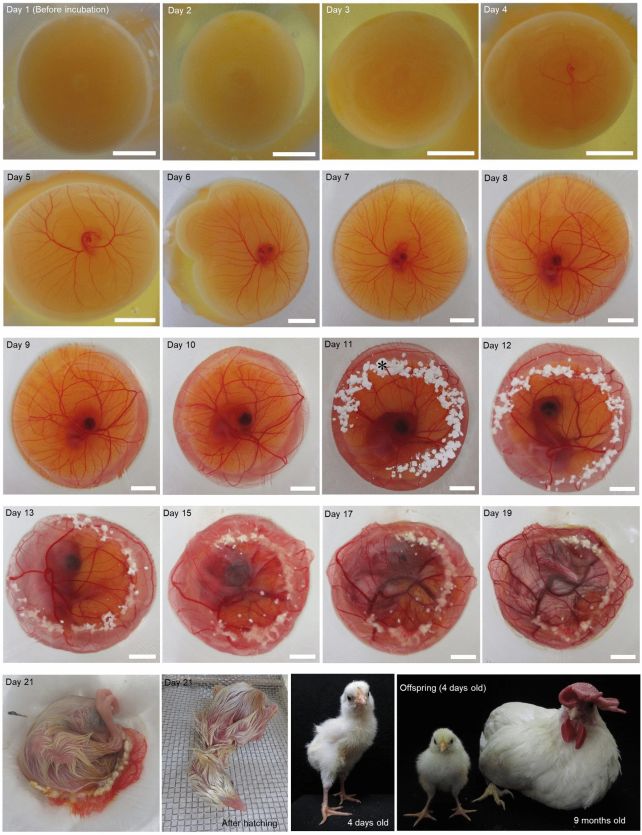The world is stuffed with birds – chirping, fluttering, waddling; feathered, beaked, and clawed. These splendidly various animals, the closest residing descendants of the magnificent dinosaurs, have efficiently made their properties on each nook of the globe.
However a part of their reproductive course of remains to be considerably mysterious: the time their growing chicks spend hidden inside opaque eggshells, growing from a zygote to a hatchling that finishes its progress to maturity tended by doting dad and mom.
Now, a long-sought aim of avian developmental biology has been realized. A workforce of scientists has developed a system for culturing eggs that replaces the opaque eggshell of home white leghorn chickens (Gallus domesticus), permitting the commentary of the chicken’s embryonic improvement from nearly go to whoa.
So profitable was the workforce’s shell-less tradition system that a number of chicks hatched efficiently on the finish of the traditional incubation interval and grew into regular chickens.
Scientists have been working for many years to attempt to develop a shell-less tradition system, or SLCS, to watch the event of an embryonic chicken. A earlier methodology that confirmed promise, first described in 2014, concerned permitting embryos to develop inside an egg for 3 days, which is required for the embryo’s survival, then eradicating them to a tradition vessel protected by a sheet of polymethylpentene kitchen cling movie.
This method, nevertheless, was not good: the chicks had been unable to develop usually, enormously lowering the hatch success fee.
A pioneer of that methodology, veterinary scientist Katsuya Obara of Okayama College of Science, alongside along with his colleague Chizuka Obara, has led a workforce that solved one of many issues hindering regular improvement and hatching.
The yolk vitelline membrane defending the layer of cells across the periphery of the embryo referred to as the blastoderm was drying out within the tradition vessel, which the workforce thought may have been impeding regular embryonic improvement.
So, to stop the membrane from drying out, the workforce mounted their tradition vessel on a rotary shaker used to generate steady movement, normally for mixing. The shaker’s high plate was set to an angle of seven levels, and the experiment was examined with completely different intervals of 6 rotations per minute, 10 rotations per minute, and 28 rotations per minute.
This prevented the membrane from drying out with a continuing movement of albumen, however improvement and survival as much as 10 days various.
At 6 rotations per minute, the survival fee was highest, however all embryos confirmed indicators of developmental delays.
At 10 rotations per minute, the survival fee was barely decrease, and a few embryos developed abnormalities, however the fee of survival for regular embryos was robust.
And, at 28 rotations per minute, the entire embryos had non-survivable abnormalities by the 10-day mark.
With 10 rotations per minute the optimum fee for each survival and improvement, the researchers experimented by including oxygen to the growing embryos at a number of completely different factors previous the 10-day mark. Though oxygen does have to be added, the timing at which this takes place does not actually affect embryo improvement.

Lastly, they carried out the identical experiment – 10 rotations per minute, with the addition of supplemental oxygen, and a sprinkling of calcium carbonate powder (the fabric that eggshells are product of), however this time they carried out extra wiggling of the tradition vessel by hand. This was carried out three to 5 instances each 3 to 10 hours within the first 24 to 48 hours of shell-less tradition.
This methodology produced the best hatch fee for regular chicks. At 10 rotations per minute, with oxygen, the hatch fee was 3.3 p.c. Including shaking back-and-forth by hand elevated the speed to 10.5 p.c.
One of many chickens that hatched was left to develop for a 12 months, then euthanized and dissected. It was fully regular. The system is profitable: it is given us a literal window to watch rooster improvement proper up till hatching.
“The event of visible-cSLCSs has opened new prospects by facilitating omnidirectional real-time monitoring of the phenotypic outcomes of experimental therapies by way of a clear plastic movie from blastoderm stage embryos till hatching,” the researchers write of their paper.
“This method will function a strong instrument in varied disciplines, resembling toxicology, stem cell analysis, bioimaging, and regenerative drugs.”
The workforce’s findings have been printed in Scientific Stories.





